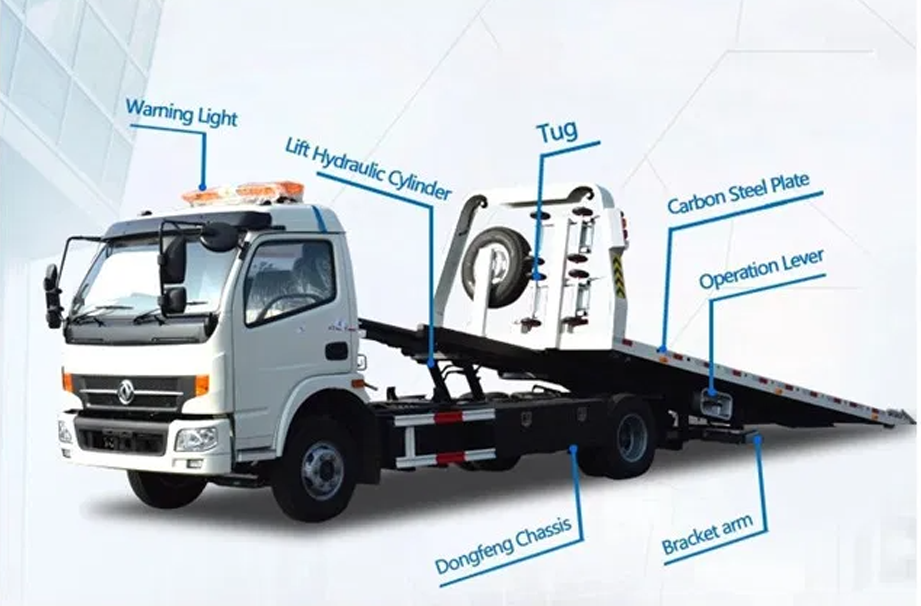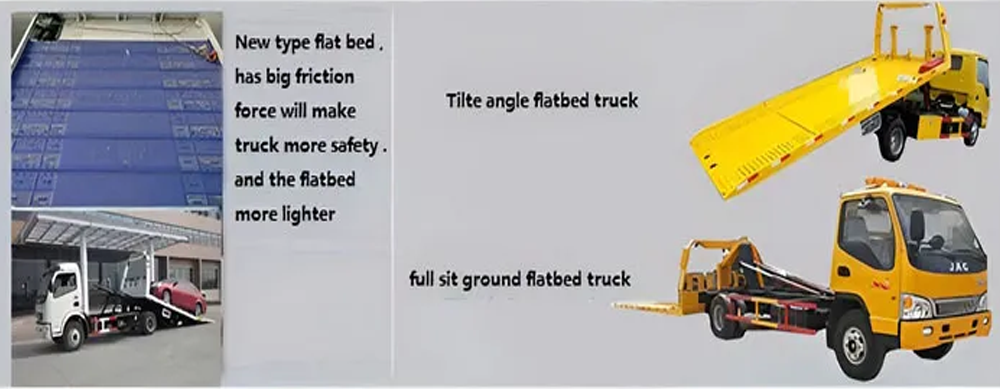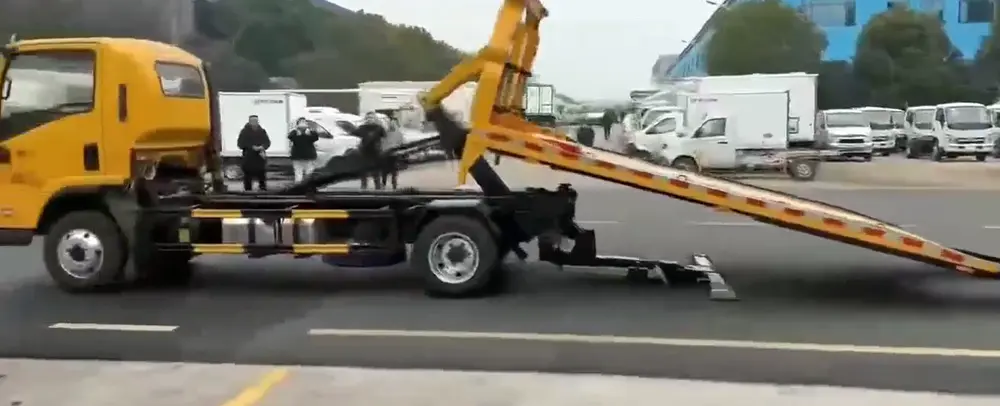Recovery Trucks are the unsung heroes of the roadside assistance and vehicle salvage industries. These heavy-duty vehicles are purpose-built to handle the most challenging recovery scenarios with remarkable efficiency and reliability.
Crafted with a rugged chassis made of high-strength steel, they can withstand the weight of incapacitated vehicles, ensuring stable transportation. The integrated winch system, often hydraulic-powered, is a force to be reckoned with, generating an immense pulling power to extract stuck or wrecked vehicles from ditches, mud, or debris.
Equipped with adjustable towing booms and a variety of robust towing attachments, they can adapt to diverse vehicle shapes and conditions. The operator's cabin is designed for comfort, furnished with ergonomic seats and intuitive controls.
| The specification of Dongfeng 3Tons Sliding Platform Recovery Truck with Crane | ||
| Specification of Chassis | ||
| Vehicle Main Dimensions | Dimensions(L x W x H)mm | 8000×2350×3300 |
| Wheel base (mm) | 3800 | |
| Overhang (front/rear) (mm) | 1180/2420 | |
| Wheel track (front/rear) (mm) | 1835/1640 | |
| Approach/Departure angle(°) | 25.5/11 | |
| Weight in KGS | Curb Weight (kg) | 6600 |
| GVW.(kg) | 8495 | |
| Drive Type | 4X2 Left Hand Drive | |
| Max. driving speed(km/h) | 99 | |
| Engine | Model | CY4102 |
| Type | 4-stroke direct injection, 6-cylinder in-line with water cooling, turbo-charging and inter-cooling | |
| Horse Power(HP) | 120 | |
| Displacement(ml) | 3856 | |
| Emission standard | Euro III | |
| Fuel Type | Diesel | |
| Gearbox | 6 forwards & 1 reverse | |
| Clutch | Reinforced diaphragm clutch | |
| Steering Gear | Power steering, hydraulic steering with power assistance | |
| Fuel tank (L) | 150 | |
| Tire | 8.25-16 ,6pcs + 1 spare | |
| Brakes | dual circuit compressed air brake | |
| Specification of Crane | ||
| Max Lifting Capacity | 5000kg | |
| Max Lifting Moment | 12.5 T.M | |
| Recommend Power | 18kw | |
| Max Oil Flow of Hydraulic System | 32L/MIN | |
| Rated Pressure Of Hydraulic System | 20MPA | |
| Oil Tank Capacity | 90L | |
| Rotation Angle | 360°All Rotation | |

1. The chassis of a recovery truck is the fundamental structural component. It's typically a heavy-duty, high-strength steel construction. This robust chassis is designed to bear the substantial weight of the recovery equipment and the disabled vehicles it will handle.
2. A crucial element of recovery trucks is the winch system. Usually, it's a powerful hydraulic- powered winch. The winch consists of a high-capacity motor, a drum around which a strong cable (often made of steel with excellent tensile strength) is wound, and a fairlead to guide the cable.
3. The towing boom is a vital part of the recovery truck. It's made of durable materials like high-strength steel or alloy to support the weight of the towed vehicle. The boom's length is often adjustable and may have an articulation system.
4. Recovery trucks come equipped with a variety of towing attachments. Heavy-duty tow hooks are designed to securely latch onto the frame or other suitable points of the vehicle being recovered.
5. The operator's cab is designed with both comfort and functionality in mind. It features an ergonomic seat to reduce operator fatigue during long-haul recovery operations. The controls for driving the truck, operating the winch, and adjusting the towing boom are laid out in an intuitive manner, allowing for easy access and operation.
6. Recovery trucks are equipped with a range of lights and safety equipment. Flashing warning lights, usually in bright colors such as amber or red, are mounted on the roof and sides of the truck to alert other road users during recovery operations.

1. Towing Capacity: Determine the maximum weight of the vehicles you'll be recovering. Recovery trucks have different towing capacities, which can range from a few tons to over a hundred tons.
2. Vehicle Compatibility: Think about the variety of vehicle shapes and sizes. Some recovery trucks are better for low-slung sports cars, while others are more suitable for tall and wide vehicles like RVs or large commercial trucks.
3. Winch Power: The winch is a critical component. Look for a powerful hydraulic-powered winch. The winch's pulling force, measured in pounds-force (lbf), should be strong enough to pull the heaviest vehicles you expect to recover.
4. Recovery Attachments: Examine the types and quality of the towing and recovery attachments. This includes heavyduty hooks, chains, straps, and any specialized equipment like wheel-lift attachments or under-reach systems.
5. Boom Strength and Flexibility: The towing boom should be strong and durable. It's usually made of high-strength steel or alloy. The boom's strength is vital to support the weight of the towed vehicle without bending or deforming.
6. Boom Reach and Adjustment: Consider the maximum reach of the boom and its ability to adjust in height and angle. This is important when dealing with vehicles of different sizes and shapes.
7. Chassis Strength: The chassis must be heavy-duty and capable of withstanding the heavy loads. A chassis made of thick, high-strength steel plates is ideal. The axle configuration and load-bearing capacity are also important factors.
8. Suspension and Tires: The suspension system should be able to handle the weight and provide a smooth ride. Heavy-duty leaf springs or air-suspension systems are common options.
9. Operator's Comfort: The cab should be designed for the comfort of the operator. This includes features like an ergonomic seat with good lumbar support, ample legroom and headroom, and a climate-control system (air-conditioning and heating).

Recovery trucks are engineered to handle substantial loads, possessing the power and strength to retrieve a diverse array of vehicles. Whether it's a small sedan stuck in a ditch, a large commercial truck with a mechanical failure, or even heavy construction equipment immobilized on a worksite, these trucks can manage it.
A defining feature is the winch system, frequently hydraulic-powered for maximum pulling prowess. These winches are equipped with high-capacity motors that wind and unwind cables of excellent tensile strength, usually made of steel.
The towing boom is a crucial component that combines strength and flexibility. Crafted from durable alloys such as high-strength steel, it can bear the weight of heavy vehicles without buckling.
These trucks come stocked with a variety of towing attachments. Heavy-duty tow hooks are designed to latch firmly onto the frame or other suitable points of the vehicle being recovered.
The chassis of a recovery truck is a heavy-duty, high-strength steel structure. It functions as the backbone, supporting the weight of the truck and the recovered vehicle.
The operator's cab is designed with operator comfort and operational ease as top priorities. It houses an ergonomic seat to reduce fatigue during long recovery operations.
Recovery trucks are outfitted with an array of safety features. Flashing warning lights, typically in bright amber or red, adorn the roof and sides to alert other road users during recovery operations.

